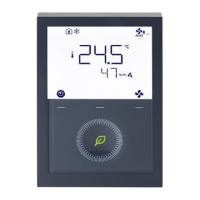IAQ - CO
2
S-Mode objects:
● 100 Built-in room air quality values (out)
● 101 External room air quality values (in, for M/S – manager/subordinate
function)
● 102 DC damper demand (1-byte out)
● 103 On/Off damper demand (1-bit in)
The CO
2
concentration is available on the bus via S-Mode object 100 “Built-in room
air quality value”. This information can share the CO
2
concentration in the rooms to
an independent fresh air controller.
S-Mode object 102 “DC damper demand” and object 103 “On/Off damper demand”
can share the current damper position to 3rd party equipment.
When the thermostats use M/S - manager/subordinate function, the CO
2
concentration of the manager can be received from the subordinate device via S-
Mode object 101 “external room air quality value”.
IAQ - CO
2
control with DC damper: P453 = 1
If DC 0...10 V damper control is selected, the following parameters are available:
● P453: Indoor air quality damper (1 = DC 0...10 V (U1))
● P454: IAQ damper proportional band Xp
● P455: Minimum damper position
● P457: Maximum damper position
● P353, P357: Fan min. output
The following graphics show DC damper position during heating/cooling demand
and in the dead zone; the fan is switched on via IAQ demand.
The damper position is based on CO
2
value. The damper is open if CO
2
(IAQ)
concentration is higher than the setpoint (P023).
When an independent air ventilation system provides fresh air in the room, the
following setting is relevant:
● When P458 (fan during IAQ control) = ON, the fan runs during IAQ demand.
● When P458 = OFF, the fan does not operate during IAQ demand.
For fan coil systems (P458 = ON), in the dead zone (no H/C demand), the damper
does not open, and the fan does not operate until CO
2
concentration reaches IAQ
setpoint + ½ P-band.
For universal heating / cooling systems (without fan control), the damper is
controlled by the IAQ demand. Fan remains OFF.
DC damper can be connected directly to thermostat terminal U1 or controlled via
S-Mode object 102: DC damper demand.

